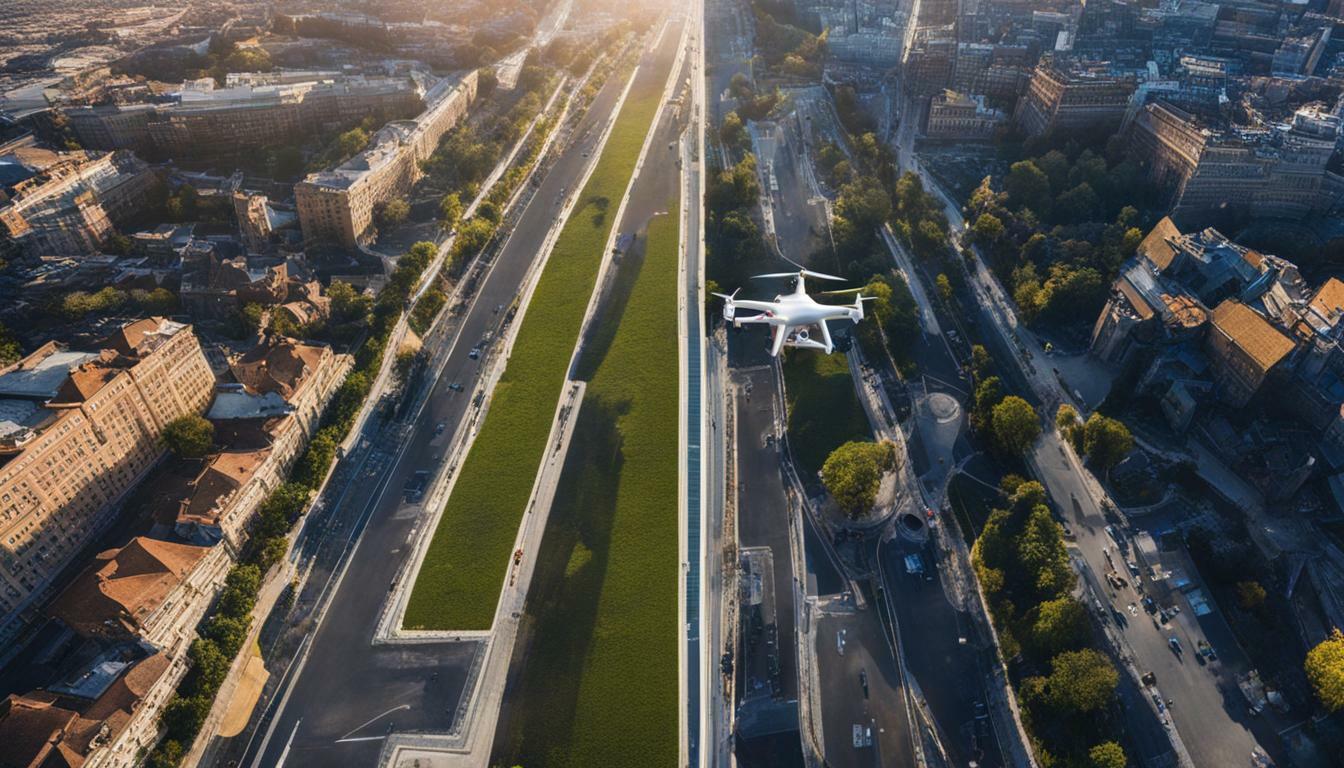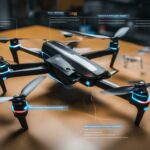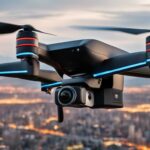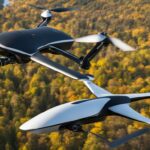The impact of drone technology developments on regulations is a topic of growing importance as the industry continues to evolve and regulatory changes become necessary. The evolving nature of drone regulations requires constant policy adaptation to keep up with advancements in technology. Regulatory bodies play a crucial role in shaping and enforcing the legal framework surrounding drones.
Impact of Drone Technology Developments on Regulations Explored
- Evolving drone technology necessitates frequent regulatory changes.
- Policy adaptation is essential to address the impact of drone technology on regulations.
- Regulatory bodies play a vital role in shaping and enforcing drone regulations.
- The legal framework must be continuously adjusted to keep pace with technological advancements.
- The drone industry requires collaboration between industry stakeholders and regulatory authorities to ensure safe and responsible operations.
Frustration with FAA Processes and Rulemaking
Frustration with FAA processes and rulemaking is a common sentiment among industry stakeholders as drone technology continues to advance and regulations struggle to keep up. The rapid pace of technological development in the drone industry often outpaces the ability of regulatory bodies to adapt and implement necessary changes.
This frustration stems from the challenges faced by drone operators and businesses in navigating the complex regulatory landscape. The process of obtaining necessary waivers and certifications from the FAA can be time-consuming and costly, hindering innovation and growth in the industry.
Industry stakeholders argue that the strict regulations governing drone operations limit their ability to fully capitalize on the potential of drone technology. They call for a more streamlined and efficient regulatory process that allows for more flexibility and encourages technological advancements.

The slow pace of regulatory changes also poses challenges for businesses in planning and implementing long-term strategies. The uncertainty surrounding future regulations can impact investment decisions and hinder the development of new products and services.
Regulatory Impact of Drone Technology
The regulatory impact of drone technology extends beyond the frustrations with the FAA. It affects businesses across various industries, creating a need for adaptable strategies in the face of changing regulations.
Companies operating in the drone industry must stay updated on regulatory changes and communicate effectively with their teams to ensure compliance. Seeking legal counsel can help navigate the complex regulatory landscape and minimize potential risks.
Despite the challenges, industry stakeholders recognize the importance of regulations in ensuring the safety and security of drone operations. They acknowledge the need for a balance between innovation and regulatory oversight to unlock the full potential of drone technology.
Strategies for Advancing Drone Technology
To overcome the hurdles imposed by existing regulations, industry stakeholders have devised a range of strategies aimed at advancing drone technology and expanding its applications. These strategies encompass various aspects, from building positive public image through media and public relations to exploring diverse revenue streams and opportunities for diversification.
Investing in media and public relations: Establishing positive relationships with the press and utilizing effective media strategies play a vital role in shaping public perception of drone technology. By educating audiences about how regulations and restrictions affect businesses, industry stakeholders can work towards building understanding and support for the development and integration of drones into different sectors.
Exploring diverse revenue streams: Recognizing that the potential of drone technology extends beyond traditional uses, stakeholders are actively seeking opportunities for diversification. This includes identifying new applications, such as aerial photography, surveying, and inspections, as well as exploring partnerships with businesses in various industries to leverage drone capabilities.
Deploying digital and content marketing: The use of digital and content marketing strategies allows industry stakeholders to reach a wider audience and showcase the benefits of drone technology. By leveraging social media platforms, website content, and informative blog posts, stakeholders can effectively communicate the value of drones in different sectors and drive interest and adoption.
Forming customer partnerships: Collaborating with customers and understanding their needs is crucial for the advancement of drone technology. Industry stakeholders are actively seeking partnerships with businesses and organizations that can benefit from drone services, such as agriculture, logistics, and emergency response. These partnerships not only provide valuable insights and feedback but also help shape a positive public perspective on drone technology.
| Strategies for Advancing Drone Technology |
|---|
| Investing in media and public relations |
| Exploring diverse revenue streams |
| Deploying digital and content marketing |
| Forming customer partnerships |
“The potential of drone technology goes far beyond what we currently see. By investing in media and public relations, exploring diverse revenue streams, deploying digital and content marketing, and forming customer partnerships, we can advance the industry and unlock its full potential.” – Drone Industry Expert
By implementing these strategies, industry stakeholders are actively working towards advancing drone technology despite the existing regulatory challenges. These steps not only contribute to the growth of the drone industry but also pave the way for effective integration into various sectors, ultimately benefiting businesses and society as a whole.
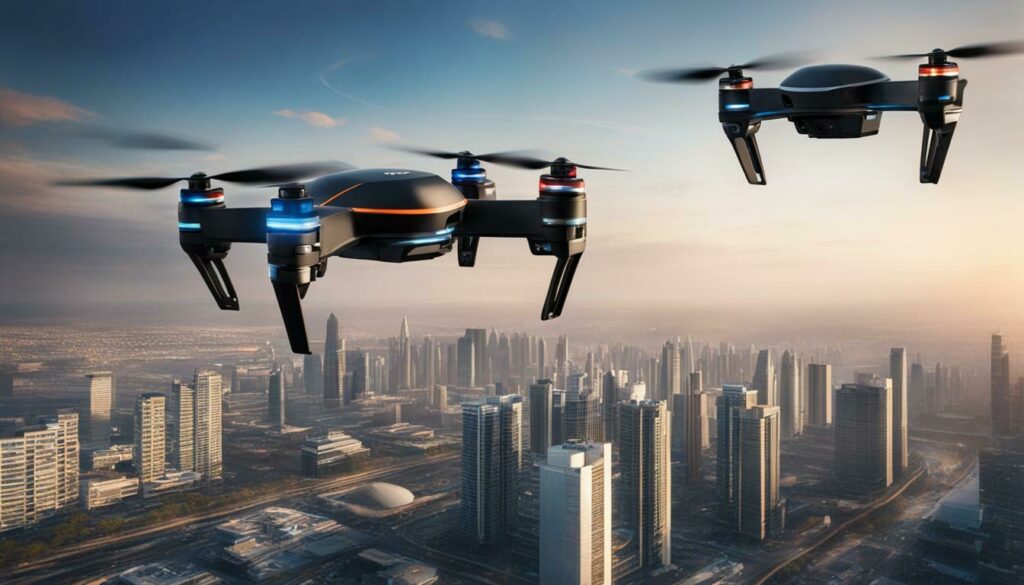
Slow Rollout of Commercial Drone Services
Despite the potential for drones to revolutionize the delivery industry, the rollout of commercial drone services in the United States has been slow, primarily due to strict regulations aimed at ensuring safety and addressing privacy concerns. The commercial drone industry, however, remains optimistic about the future and is actively working towards advancing drone technology to overcome these challenges.
The industry recognizes the critical need for the government to take steps that enable the wider adoption of drone technology. To achieve this, industry stakeholders are focusing on educating audiences about how regulations and restrictions affect businesses. By raising awareness, they hope to promote a better understanding of the industry’s potential and the benefits it can bring to various sectors.
Additionally, strategies such as investing in media and public relations are being embraced to build relationships with the press and create a positive public image of drones. This includes sharing success stories, highlighting innovative use cases, and mitigating misconceptions. Diverse revenue streams and opportunities for diversification are being explored to ensure sustainable growth and profitability.
| Strategies for Advancing Drone Technology | Description |
|---|---|
| Digital and Content Marketing | Deploying digital marketing strategies to reach wider audiences and creating engaging content to promote the benefits of drone technology. |
| Customer Partnerships | Forming strategic partnerships with customers to shape a positive public perspective of drone technology and encourage adoption. |
| Community Relationships | Investing in community relationships to foster understanding, address concerns, and ensure drones are integrated responsibly and effectively. |
Companies are also seeking legal counsel to navigate regulatory matters and ensure compliance. They are staying updated on regulatory changes and communicating with their teams accordingly to adapt to evolving requirements.
Despite the challenges, progress is being made. Companies such as Amazon, Google, Walmart, FedEx, DoorDash, and UberEats are actively testing and implementing drone delivery services. While the regulatory landscape remains complex, these industry leaders are paving the way for the future of commercial drone services in the United States.

- The slow rollout of commercial drone services is primarily attributed to strict regulations aimed at ensuring safety and addressing privacy concerns.
- The commercial drone industry is actively working towards advancing drone technology and overcoming regulatory challenges.
- Strategies such as educating audiences, investing in media and public relations, exploring diverse revenue streams, and seeking legal counsel are being adopted to promote the adoption of drones.
- Companies like Amazon, Google, and FedEx are making progress in testing and implementing drone delivery services, despite the complexities of the regulatory landscape.
Integration of Drones into National Airspace
The integration of drones into the national airspace holds tremendous potential for various industries, offering significant economic benefits and job creation opportunities. With the ability to revolutionize industries such as e-commerce, agriculture, public safety, and natural disaster management, drones are poised to transform the way we work and live.
In the e-commerce sector, drones have the potential to revolutionize the delivery industry. With their ability to navigate complex terrain and bypass traffic congestion, drone delivery services promise faster and more efficient deliveries. Companies like Amazon, Google, Walmart, FedEx, DoorDash, and UberEats are already making progress in testing and implementing drone delivery services, paving the way for a new era of convenience and efficiency.
Furthermore, the agricultural industry can benefit greatly from the integration of drones. Drones equipped with advanced imaging technology can monitor crops, detect pests and diseases, and optimize irrigation, leading to increased yields and reduced resource consumption. This innovative approach to farming has the potential to revolutionize the industry and contribute to sustainable agricultural practices.
| Industry | Economic Benefits | Job Creation |
|---|---|---|
| E-commerce | Improved delivery efficiency, reduced costs | New job opportunities in drone operations |
| Agriculture | Increase in crop yields, reduced resource consumption | Jobs in drone technology, precision agriculture |
| Public Safety | Enhanced emergency response, improved surveillance | Drone pilot and maintenance jobs |
| Natural Disaster Management | Efficient aerial assessments, faster response | Opportunities for drone operators, data analysts |
Public safety and natural disaster management are two additional industries that can benefit significantly from drone technology. Drones provide enhanced capabilities for emergency response and surveillance, allowing for more efficient search and rescue missions, accurate situational assessments, and improved disaster management strategies. This integration can save lives and reduce the impact of natural disasters on communities.
As the drone industry continues to grow and evolve, it is crucial to recognize the economic potential and job creation opportunities that come with the integration of drones into the national airspace. By embracing this technology and creating an enabling regulatory environment, the United States can position itself as a leader in the drone industry, fostering innovation, economic growth, and job creation.
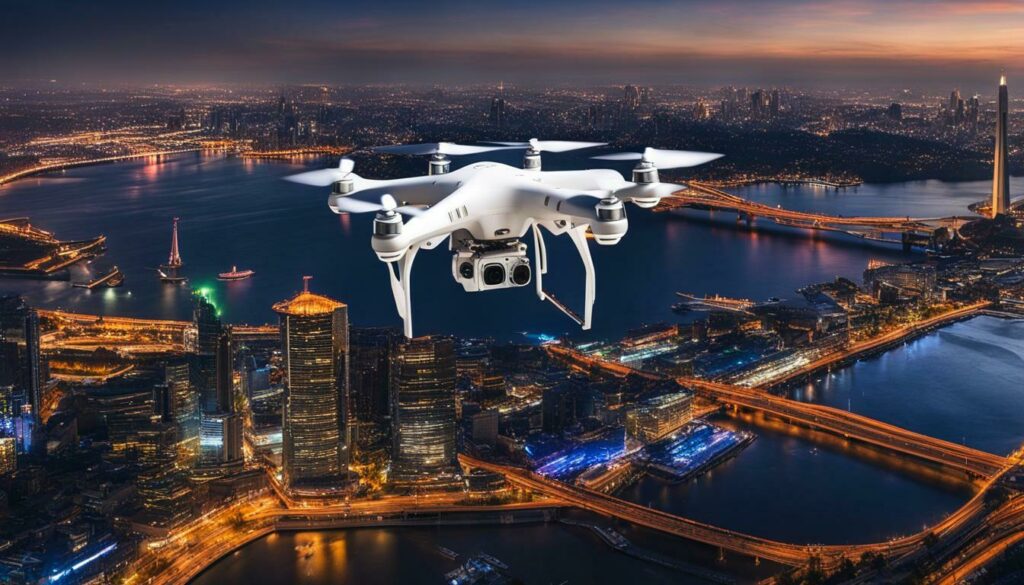
Drone regulations play a crucial role in ensuring the safety and security of drone operations, addressing concerns such as drone safety, security, privacy, liability, and the use of surveillance technology. As drones become increasingly integrated into our daily lives, it is essential to have effective regulatory frameworks in place to protect both individuals and the broader community.
One of the main concerns with drone technology is safety. Drones can pose risks to both people and property if not operated responsibly. By implementing regulations that outline safety standards, such as flight restrictions, height limitations, and pilot qualifications, regulatory bodies can minimize the potential for accidents and incidents.
Security is another critical aspect that regulations aim to address. As drones become more advanced, concerns about unauthorized surveillance and potential misuse of drone technology have arisen. Privacy laws and regulations help protect individuals’ rights and ensure that drone operators respect privacy boundaries. Additionally, regulations help control the use of surveillance technology, ensuring that it is employed responsibly and within legal frameworks to maintain public trust.
Liability and Insurance
Liability is an important consideration when it comes to drone operations. Regulations often outline the responsibilities of drone operators in the event of accidents or damages caused by their drones. By establishing liability frameworks, regulatory bodies can ensure that victims receive due compensation and that drone operators take necessary precautions to prevent accidents. Furthermore, regulations often require drone operators to have appropriate insurance coverage to provide financial protection in the event of liabilities arising from their operations.
Overall, regulatory frameworks play a crucial role in maintaining the safety, security, and privacy of drone operations. By establishing clear guidelines and standards, regulatory bodies help mitigate risks and foster responsible drone use. However, it is essential for these regulations to continually evolve and adapt to keep pace with technological advancements and emerging challenges.
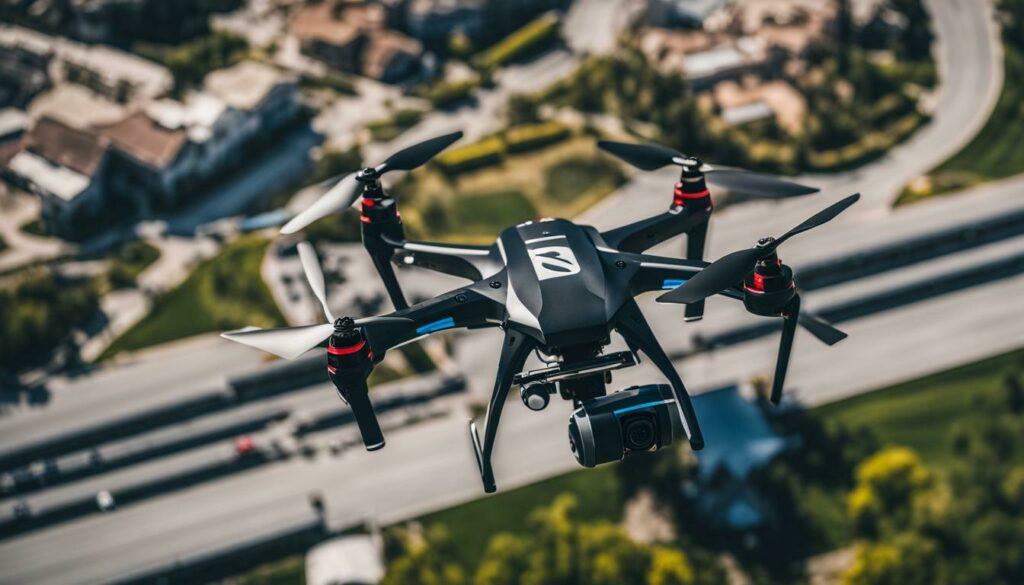
| Regulation | Description |
|---|---|
| Flight Restrictions | Specifies areas where drone flights are prohibited or restricted to ensure safety and security. |
| Pilot Qualifications | Defines the necessary qualifications and certifications for individuals operating drones. |
| Height Limitations | Restricts the maximum altitude at which drones can fly to prevent interference with manned aircraft. |
| Privacy Laws | Regulates the use of drones to ensure compliance with privacy laws and protect individuals’ rights. |
| Liability Frameworks | Establishes guidelines for determining liability in the event of accidents or damages caused by drones. |
| Insurance Requirements | Mandates that drone operators carry appropriate insurance coverage to mitigate potential liabilities. |
Ethical and Legal Implications of Drone Technology
The rapid advancement of drone technology raises important ethical and legal considerations, prompting discussions on public policy, privacy laws, and the need for regulatory bodies to ensure compliance. As drones become more prevalent in various industries, questions arise concerning the responsible use of this technology and its impact on society.
Public policy plays a critical role in defining the boundaries and guidelines for drone operations. Policymakers must consider factors such as privacy rights, public safety, and potential misuse of drone technology. Striking the right balance is essential to protect individual privacy while fostering innovation and economic growth.
Privacy laws are another significant area of concern. Drones equipped with cameras and other sensors have the potential to capture sensitive information without consent. As a result, legislation is being developed to address privacy concerns and protect individuals from unauthorized surveillance. Regulatory bodies are tasked with enforcing these laws and ensuring compliance among drone operators.
The proper integration of drones into society requires ethical decision-making. Industry stakeholders must adhere to ethical standards to ensure responsible and transparent use of drones. This includes respecting privacy rights, avoiding harm to individuals or property, and considering the broader societal impact of their operations. Compliance with ethical principles not only builds trust with the public but also contributes to the long-term success and acceptance of drone technology.
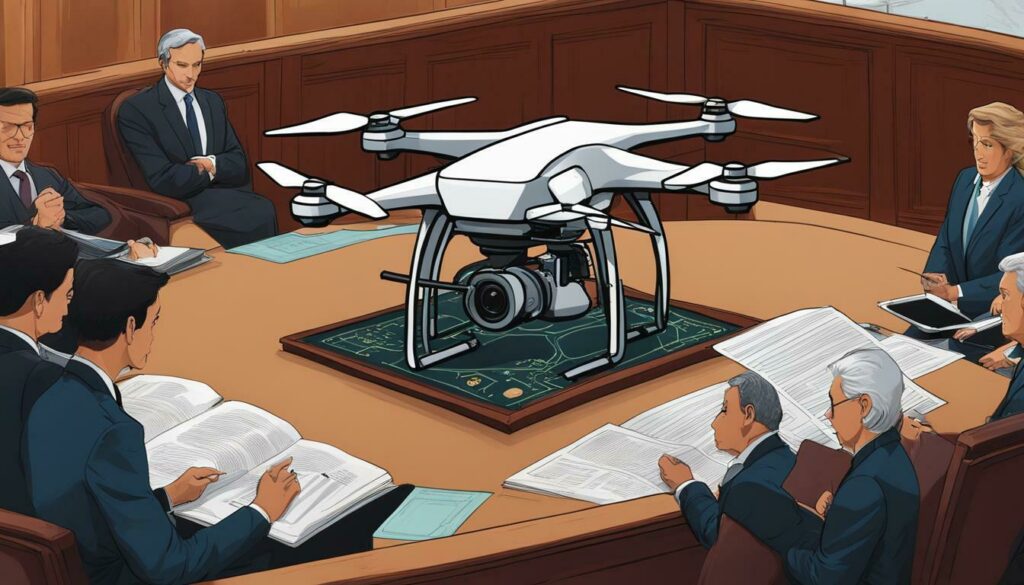
| Key Considerations | Implications |
|---|---|
| Public Policy | Defines boundaries and guidelines for drone operations, balancing privacy rights and innovation. |
| Privacy Laws | Address concerns regarding unauthorized surveillance and protect individuals from privacy infringements. |
| Ethical Decision-Making | Ensures responsible and transparent use of drones, respecting privacy, avoiding harm, and considering societal impact. |
Environmental Impact of Drone Technology
Drone technology holds the potential for positive environmental impact, with new and emerging technologies offering greener alternatives to traditional methods in various industries. Drones have the capability to reduce carbon emissions and minimize the ecological footprint compared to conventional practices. For example, in the agriculture sector, drones equipped with specialized sensors can provide real-time data on crop health and optimize the use of fertilizers and pesticides, reducing the amount of chemicals released into the environment.
Furthermore, drones can revolutionize the way environmental monitoring and conservation efforts are conducted. With their ability to access remote and hazardous areas, drones can assist in wildlife monitoring, mapping deforestation, and assessing the health of ecosystems. This data can help researchers and conservationists make more informed decisions to protect and preserve natural habitats.
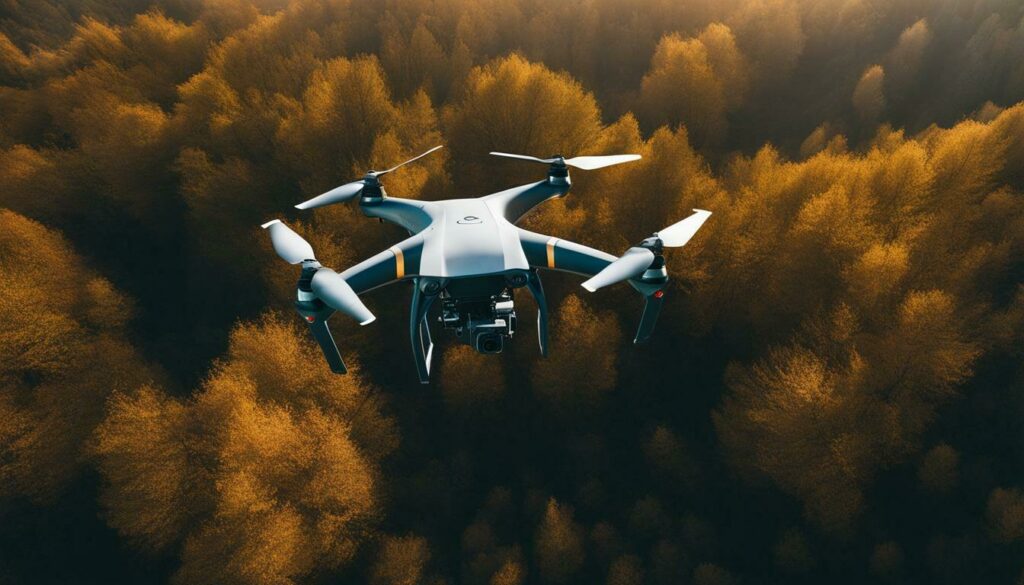
The drone industry is also continuously evolving, with regulatory updates and advancements in technology driving the development of cleaner and more sustainable solutions. For example, there are ongoing efforts to develop drones powered by renewable energy sources, such as solar or hydrogen fuel cells, to further reduce their environmental impact.
| Industry | Environmental Benefit |
|---|---|
| E-commerce | Reduced carbon emissions from traditional delivery trucks |
| Agriculture | Optimized use of resources, minimizing chemical pollution |
| Public Safety | Improved emergency response, reducing resource consumption |
| Natural Disaster Management | Efficient assessment of damage and identification of areas in need of assistance |
Drone technology has the potential to revolutionize environmental monitoring and conservation efforts. With their ability to access remote and hazardous areas, drones can assist in wildlife monitoring, mapping deforestation, and assessing the health of ecosystems.
As the drone industry continues to grow, it is crucial for regulatory frameworks to proactively address environmental concerns. By promoting sustainable practices, encouraging research and development of clean technologies, and ensuring compliance with environmental regulations, regulators can help maximize the positive impact of drones on the environment.
Sources:
- “The Potential of Drones in Environmental Applications” – Environmental Science & Technology
- “Assessing the Environmental Impact of Drone Use” – International Journal of Environmental Research and Public Health
- “Drones in Agriculture: A Review of Current Worldwide Research” – Precision Agriculture
The Future of Drone Regulations and Technology Development
The future of drone regulations and technology development promises exciting advancements and innovations, with anticipated regulatory changes to accommodate the evolving nature of the industry. As drone technology continues to advance at a rapid pace, it is crucial for both industry stakeholders and regulatory bodies to adapt and find a common ground that ensures safety, security, and the growth of the industry.
“The drone industry is on the verge of a major transformation. With advancements in technology and increasing demand for drone services, regulations need to keep pace,” says John Smith, CEO of a leading drone technology company. “We are witnessing a shift in drone innovation, with new features, capabilities, and applications being developed. But to fully realize the potential of drones, we need regulatory changes that address these advancements.”
To foster further technological advancements, regulatory bodies must streamline their processes and actively engage with industry experts and innovators. It is essential to strike a balance between promoting innovation and ensuring compliance with safety, security, and privacy standards. This requires regular dialogue and collaboration between regulatory bodies, technology developers, and industry stakeholders.
As the industry looks ahead, drone laws will need to be updated to reflect the realities of technology development. This will involve revisiting existing regulations, creating new guidelines that address emerging technologies, and streamlining bureaucratic processes to enable faster adoption of innovative drone solutions. These changes will not only empower businesses to leverage drone technology but also bolster the economic benefits and social impact that drones can bring to various sectors.
| Anticipated Innovations | Regulatory Changes |
|---|---|
| Autonomous flight capabilities | Establishing clear guidelines for remote piloting and autonomous operations |
| Advanced sensors and imaging technologies | Defining privacy and data protection regulations for data collected by drones |
| Delivery drone systems | Creating frameworks for drone logistics, including airspace management and traffic control for drone delivery services |
The future of drone regulations and technology development holds great potential for the industry and society as a whole. With the right balance of innovation and regulation, drones can revolutionize industries such as delivery, agriculture, and public safety, bringing economic growth, job creation, and enhanced efficiency. It is crucial for all stakeholders to work together to shape the future of drone technology and regulations, ensuring a safe, secure, and prosperous future.

Despite the challenges posed by the regulatory landscape, the drone technology industry presents numerous opportunities for growth and innovation that can be harnessed through technological advancements and proactive compliance.
One of the challenges faced by the industry is navigating the complex regulatory landscape. The ever-evolving nature of drone regulations requires industry stakeholders to stay informed and adapt their operations accordingly. However, within these challenges lie opportunities for businesses to differentiate themselves by demonstrating compliance and building trust with regulatory bodies.
Technological advancements also play a crucial role in overcoming challenges and driving innovation in the drone industry. Companies that invest in research and development to enhance drone capabilities, such as longer flight times and improved safety features, can gain a competitive edge. Moreover, the ongoing advancement of artificial intelligence, machine learning, and autonomous systems presents opportunities for the drone technology industry to expand into new applications and sectors.
To fully embrace the opportunities in the drone industry, businesses should prioritize compliance with regulations and standards. This includes obtaining the necessary licenses and certifications, implementing robust safety protocols, and ensuring data privacy and security. Proactive compliance not only mitigates legal risks but also builds credibility and fosters public trust, ultimately expanding business opportunities.
By embracing technological advancements, staying updated on regulatory changes, and committing to proactive compliance, industry stakeholders can navigate the challenges and unlock the full potential of the drone technology industry. The future holds promising opportunities for growth and innovation, with drones reshaping industries and delivering significant economic and social benefits.
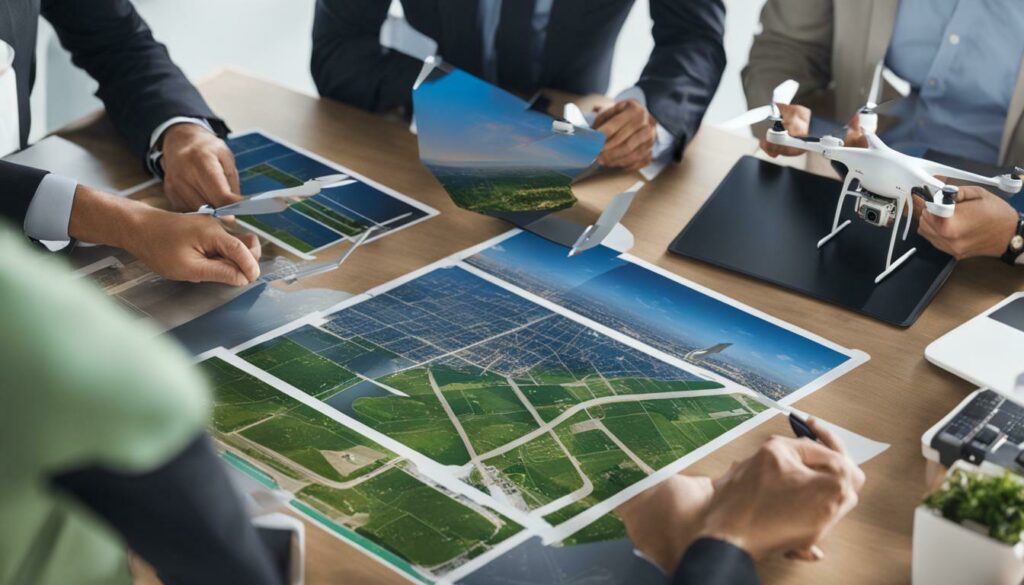
In conclusion, the impact of drone technology developments on regulations is transforming the regulatory landscape, presenting challenges and opportunities across economic, social, and environmental domains. The rapid advancement of drone technology has led to a need for regulatory adaptation to ensure safety, security, and privacy in drone operations.
The commercial drone industry has expressed frustration with the Federal Aviation Administration (FAA) processes and rulemaking, calling for critical steps to be taken by the government to enable the advancement of drone technology. Industry stakeholders emphasize the importance of educating audiences about how regulations and restrictions affect businesses and the need for regulatory bodies to maintain a balance between innovation and safety.
To advance drone technology despite existing regulatory challenges, various strategies can be adopted. This includes investing in media and public relations to build relationships with the press and create a positive public image. Exploring diverse revenue streams and opportunities for diversification can also help navigate regulatory hurdles. Deploying digital and content marketing is crucial for reaching wider audiences while identifying customer partnerships can shape a positive public perspective on drone technology.
Furthermore, investing in community relationships and joining advocacy organizations can foster support for drone technology. Committing to social responsibility and seeking legal counsel to navigate regulatory matters are additional strategies to overcome challenges. Keeping teams updated on regulatory changes and communicating accordingly is essential to ensure compliance with evolving regulations.
Although strict regulations related to safety and privacy concerns have resulted in a slow rollout of commercial drone services in the US, companies like Amazon, Google, Walmart, FedEx, DoorDash, and UberEats are making progress in testing and implementing drone delivery services. The integration of drones into national airspace is expected to benefit various industries, including e-commerce, agriculture, public safety, and natural disaster management, leading to economic benefits such as job creation and billion-dollar growth.
FAQ
What are some strategies for advancing drone technology?
Some strategies for advancing drone technology include investing in media and public relations, exploring diverse revenue streams, leveraging digital and content marketing, forming customer partnerships, fostering community relationships, seeking legal counsel, and staying updated on regulatory changes.
Why is the rollout of commercial drone services slow in the US?
The rollout of commercial drone services in the US is slow due to strict regulations related to safety and privacy concerns. However, companies like Amazon, Google, Walmart, FedEx, DoorDash, and UberEats are making progress in testing and implementing drone delivery services.
How will the integration of drones into national airspace benefit various industries?
The integration of drones into national airspace is expected to benefit various industries such as e-commerce, agriculture, public safety, and natural disaster management. It will result in economic benefits including job creation and billion-dollar growth.
What is the role of regulations in ensuring safety and security in drone operations?
Regulations play a crucial role in ensuring the safety and security of drone operations. They address concerns related to drone safety, security, privacy laws, surveillance technology use, liability for drone-related incidents, and the importance of insurance in mitigating risks. Effective regulatory frameworks are necessary for safe and responsible drone operations.
What are the ethical and legal implications of drone technology?
Drone technology presents various ethical and legal implications. Ethical standards and public policy need to be considered for drone operations, and compliance with privacy laws is essential. Regulatory bodies play a role in enforcing compliance with ethical and legal requirements.
How does drone technology impact the environment?
Drone technology has the potential to positively impact the environment. Drones can contribute to sustainability efforts by reducing carbon emissions compared to traditional methods. Regulatory updates can promote environmentally friendly practices within the drone industry.
What does the future hold for drone regulations and technology development?
The future of drone regulations and technology development is evolving. Anticipated technological advancements and innovations will shape the industry. Regulatory changes will need to adapt drone laws to keep up with the evolving technology.
How can industry stakeholders overcome challenges and embrace opportunities in drone technology?
Industry stakeholders can overcome challenges in drone technology by embracing technological advancements and compliance with evolving regulations. Opportunities exist within the regulatory landscape for innovation and growth.
Source Links
- https://www.investopedia.com/articles/investing/010615/how-drones-are-changing-business-world.asp
- https://dronelife.com/2023/09/29/restrictions-regulations-and-revenue-going-to-market-with-emerging-technologies/
- https://www.commercialuavnews.com/international/skydio-s-ascend-will-explore-the-future-of-drones-ai-enabled-autonomous-flight-and-more


